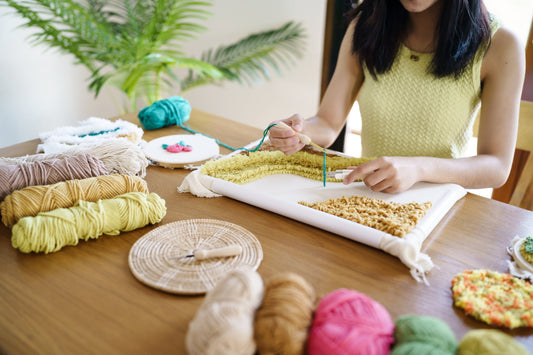
How to Wall Hang a Latch Hook Rug: Different Methods Explained
Introduction: Why Wall Hang a Latch Hook Rug?
Your latch hook rug is more than just a floor decoration; it can be a beautiful piece of art to display on your walls. Whether you’ve created it using a latch hook rug kit or as a custom design, wall hanging preserves its condition and showcases your work. In this guide, we’ll explore the different methods to safely and elegantly hang your latch hook rug on the wall.
Method 1: Sewing a Fabric Sleeve
A common and simple method to hang a latch hook rug is by sewing a fabric sleeve or pocket onto the back of the rug. This sleeve allows you to slide a wooden dowel through, making it easy to hang the rug securely on hooks or nails. Start by cutting a piece of fabric, folding and sewing it into a sleeve shape. Then, attach the sleeve to the back of your rug using a whip stitch, ensuring the stitching blends with the loops of the rug so it's not visible from the front.
Once the sleeve is in place, cut a dowel to the correct size, insert it into the sleeve, and hang the rug from two picture hooks to keep it stable. This method not only provides strong support for your latch hook rug, but it also distributes the weight evenly, preventing sagging.
Method 2: Using Rug Binding Tape
If you prefer a quicker solution, consider using rug binding tape to create the hanging loop. Rug binding tape can be easily sewn onto the back of your latch hook rug at the top. It’s strong enough to hold the weight of the rug and acts as a loop through which you can insert a dowel or curtain rod. While this method is similar to using a fabric sleeve, it’s faster and works well for smaller rugs or temporary displays.
After attaching the tape, slide the dowel through and hang it up using picture hooks or nails. Be sure to cut the dowel to the appropriate size so that it doesn’t extend beyond the edges of the rug for a cleaner look.
Method 3: Clip-On Hanging Solutions
For those who don’t want to sew, clip-on hanging solutions like curtain hoops are another option. These clips attach to the edges of your latch hook rug and grip the fabric securely. You can then hang the clips directly onto nails or hooks. This method is quick and doesn't require any permanent alterations to the rug, making it perfect if you like to rotate your displayed pieces often.
While convenient, this method may not work as well for heavier rugs, and the clips could potentially leave marks on the edges over time. Use this approach for lighter rugs or for short-term displays.
Method 4: Framing Your Latch Hook Rug
Framing is an elegant way to turn your latch hook rug into a true work of art. You can have the rug professionally framed using acid-free materials to ensure that it stays protected over time. When framing a rug, make sure the frame has air-permeable backing to prevent moisture buildup, which can damage the rug.
This method is ideal for smaller, detailed pieces that you want to preserve as a decorative item. The frame can be custom-made to match your home’s decor, turning your latch hook rug into a focal point on your wall.
Method 5: Velcro Hanging System
A velcro hanging system is another easy and versatile way to hang your latch hook rug. Simply sew one side of the velcro strip to the back of your rug, and attach the other side to the wall. This method allows for easy removal and rehanging, making it a flexible option for renters or for people who like to change their wall decor frequently.
Velcro strips are strong enough to hold most rugs securely, but for larger or heavier pieces, it’s a good idea to use additional support like hooks or nails along the top edge of the rug.
Conclusion: Choosing the Best Method for Your Latch Hook Rug
Each of these methods offers a safe and effective way to hang your latch hook rug on the wall. Whether you prefer sewing a fabric sleeve, using clips, or framing the rug, the method you choose should match the size and



